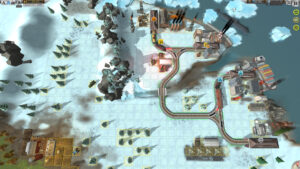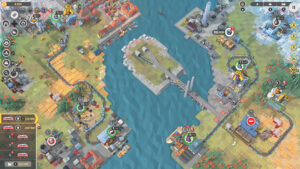Gemcraft: Environmental Hazards
I said before that I like to keep a tower dedicated to demolishing Beacons as they appear. One nice powerful yellow gem with its targeting priority set to Structures, positioned where it can hit most of the screen — I’d say all of the screen, but it’ll hit creeps when there are no structures to target, and you really want to give the mana-leeching gems first crack at them. However, some levels have elements that try to convince you not to do this.
Basically, there are structures that can be harmful to hit, and which gems will only target if they’re set to prioritize structures. One is inherited from the previous game in the series: sealed tombs, which, when cracked open, emit dense clouds of monsters, palette-swapped to pure black to reinforce the impression that they’re not so much individual creatures as a contiguous mass. These are really not so bad for the high-level player, though. Each tomb holds a finite set of monsters, and once you’e wiped them out, the tomb holds nothing more to fear.
This is not the case for the spawnling hives. Spawnlings are basically the same as swarmlings, just outside of the normal enemy waves. One of the random special powers sometimes assigned to a wave of giants is “spawns 3 spawnlings on death”, which isn’t that big a deal as long as you have multiple killing points along the path. These hives, though, are something else. They emit spawnlings when attacked, and the more they’re attacked, the tougher the spawnlings get. Understand that a high-grade gem can fire over a hundred shots per second. If you set such a gem to prioritize structures and put it in range of a hive, you can wind up with ultra-powerful spawnlings, ones that you don’t have a prayer of killing, before you realize what you’ve done and correct your mistake.
Then there’s the corrupted mana shards. Mana shards are environmental features that are basically like mines in an RTS: firing at them with gems gives you extra mana until the supply runs out. Very often there’s also a crust you have to break through before you can start harvesting them productively. Corrupted mana shards are similar, except for two things: they never run out of mana, and they eat away at any gem that fires on them, making it do less damage and, consequently, harvest less mana. As far as I can tell, the result is that harvesting a corrupted shard just isn’t worth it. The amount of mana that a gem can get out of it before it’s rendered useless is always going to be less than the cost of the gem. They’re not as disastrous as a spawnling hive, but still best avoided.
Accommodating these things is a nice little extra puzzle in the few levels where they appear. You want to cover as much ground as you can without accidentally hitting them, and that means placing towers where their circles of effect will leave just the right gaps. I wish the levels did more of this sort of thing.
 Comments(0)
Comments(0)
